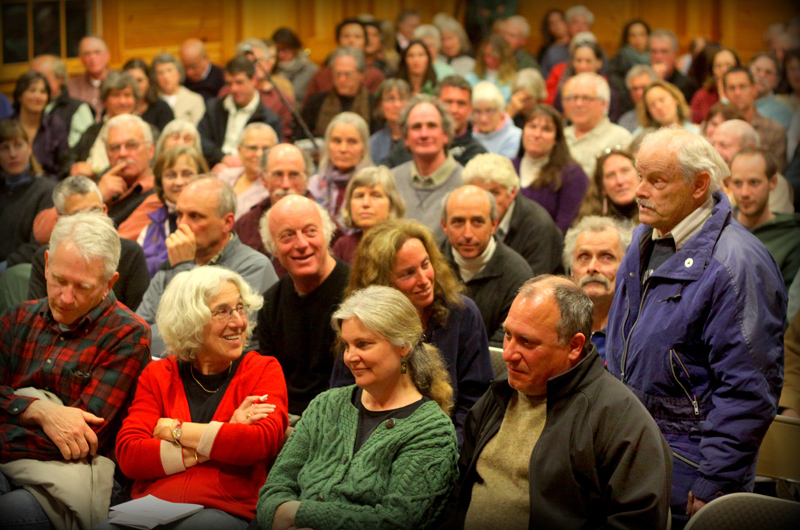Following nearly a year and a half of wide-ranging and sometimes emotional debate about the impact of large houses on the rural character of Chilmark, voters overwhelmingly approved a new bylaw to limit house size at their annual town meeting this week.
“Other towns have talked about it and done nothing,” selectman Warren Doty said. “This will be a landmark bylaw that other people will look to.”
Other voters and longtime Chilmarkers echoed the sentiment.
“I applaud our planning board for responding to the wishes of our citizens and drafting the bylaw we are voting on tonight,” said Susan Parker.
“We wanted to come up with a way that most people would be able to do something with their property; we didn’t want to put in something so restrictive,” said planning board chairman Janet Weidner. “The other side of the coin is these extra large properties that seem out of character with what we believe Chilmark is.”
Not everyone felt the same way.
“I think it’s too restrictive,” said Debbie Hancock. “It’s all good intentions . . . but most important, I believe this is going to bring down Chilmark town values and in turn raise our taxes.”
Frank LoRusso, who is chairman of the town zoning board of appeals, agreed. “I believe some of the criteria we’re supposed to follow is much too radical and I think it’s going to be a real problem for us at the zoning board,” he said.
In the end the bylaw was approved 162 to 51.
A total of 220 voters turned out for the meeting at the Chilmark Community Center, guided by longtime moderator Everett Poole. A large overflow group of nonvoters gathered in the entryway outside the room.
The vote on the big house bylaw marks the end of 15 months of planning by the town planning board and a volunteer subcommittee. The bylaw calls for an extra layer of review and a special permit from the zoning board of appeals for new houses on three acres that are more than 3,500 square feet, and limits total living area to 6,000 square feet. Homeowners are allowed 250 square feet per additional acre. Existing homes that already exceed the threshold will be given a one-time exception to increase the total living area by five per cent. Definitions for detached bedrooms will be tightened and clarified.
Voters moved swiftly through the first 30 articles on the warrant, approving nearly all, including an $8.1 million town operating budget for the coming year, up $360,000 over last year largely due to school spending and a 2.4 per cent cost of living increase for town employees. Higher student enrollment in the up-Island regional school district and needed repairs to the drainage system at the Chilmark School are the principal added cost centers.
A $50,000 spending article to pay for the town’s share of the Other Post Employment Benefit (OPEB) fund for municipal employees was indefinitely postponed due to an unexpected shortage in free cash this year. Voters will take up the funding at a fall special town meeting instead, town executive secretary Tim Carroll said.
Voters also approved a transfer of $300,000 from the general stabilization fund to pay for road resurfacing on Tabor House Road and North Road, and $39,000 from the general stabilization fund for the towns’ share of a new ambulance for the Tri-Town Ambulance Service and $31,000 for a new police cruiser. A corresponding Proposition 2 1/2 question appears on the annual town election ballot.
Police chief Brian Cioffi asked voters to approve $3,500 for the Martha’s Vineyard Law Enforcement Council. Mr. Cioffi said the money helps to fund training for the Island’s tactical team, which responded to the Boston marathon bombing twice last week. Two Chilmark police officers are part of the team. The article passed unanimously.
And finally came the bylaw question, the last article on the warrant
Voters lined up to cast their vote in an Australian ballot count, which allows for voters to cast ballots on slips of paper.
First, an amendment to increase the threshold from 3,500 square feet per three acres to 4,000 square feet failed on the floor. Voters did agree to an amendment that calls for a joint review of the bylaw on a biannual basis to review its impact.
According to town assessors data used by the planning board, the average house in Chilmark is 2,300 square feet. There are a total of three million square feet in the town of Chilmark; very large houses (more than 6,000 square feet) make up about one per cent of that number.
This is the second time a large house bylaw has come before voters; in 1991 the town turned down a bylaw to limit house size.
“This is the only town on this Island to have attempted to take this step,” said Steve Bernier. “Tonight should be a celebration of the courage [of the planning board] for trying to get their arms around this elephant. We can come back and improve on this . . . but tonight we should rally together and let go of our individualism and think about this community that we love.”
There were passionate stories about old Chilmark. Frank Dunkl recalled when his family first purchased their North Road property 50 years ago.
“At the time we were woken up at dawn by a chorus of bird noises that were so seriously strong you couldn’t sleep any longer,” he recalled. “This is the type of thing that brought people to Martha’s Vineyard . . . if you want suburbia, what in the world are you doing here?”
Mrs. Parker said she wanted to “see the resources preserved for future generations.”
After more than an hour of debate, Mr. Poole called for a vote, and the bylaw was approved as amended on the town meeting floor. The article required a two-thirds majority to pass.
As the evening concluded, planning board member Catherine Thompson thanked Mrs. Weidner for her dedication to the board as chairman for the past four years. It was met with a standing ovation.
The annual town election is Tuesday, the same day as the special state primary. Polls are open at the Community Center from 7 a.m. to 8 p.m. There are no elected contests on the ballot.
A previous version of this article inncorrectly identified one of the people in the top photo delivering a standing ovation for planning board chairman Janet Weidner. It is Susan Heilbron, not Abby Rabinovitz.






Comments (14)
Comments
Comment policy »